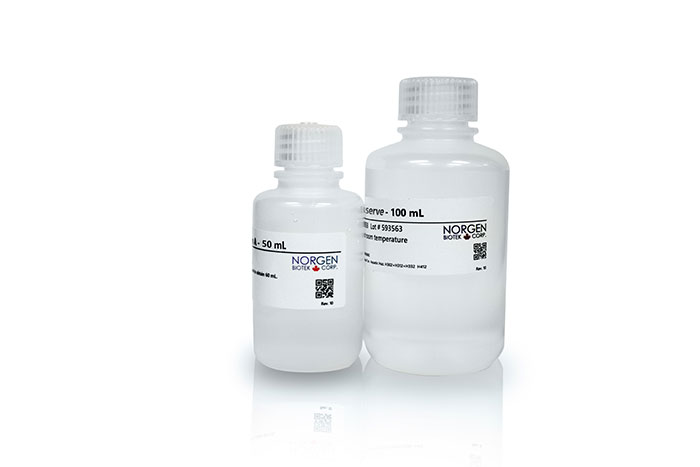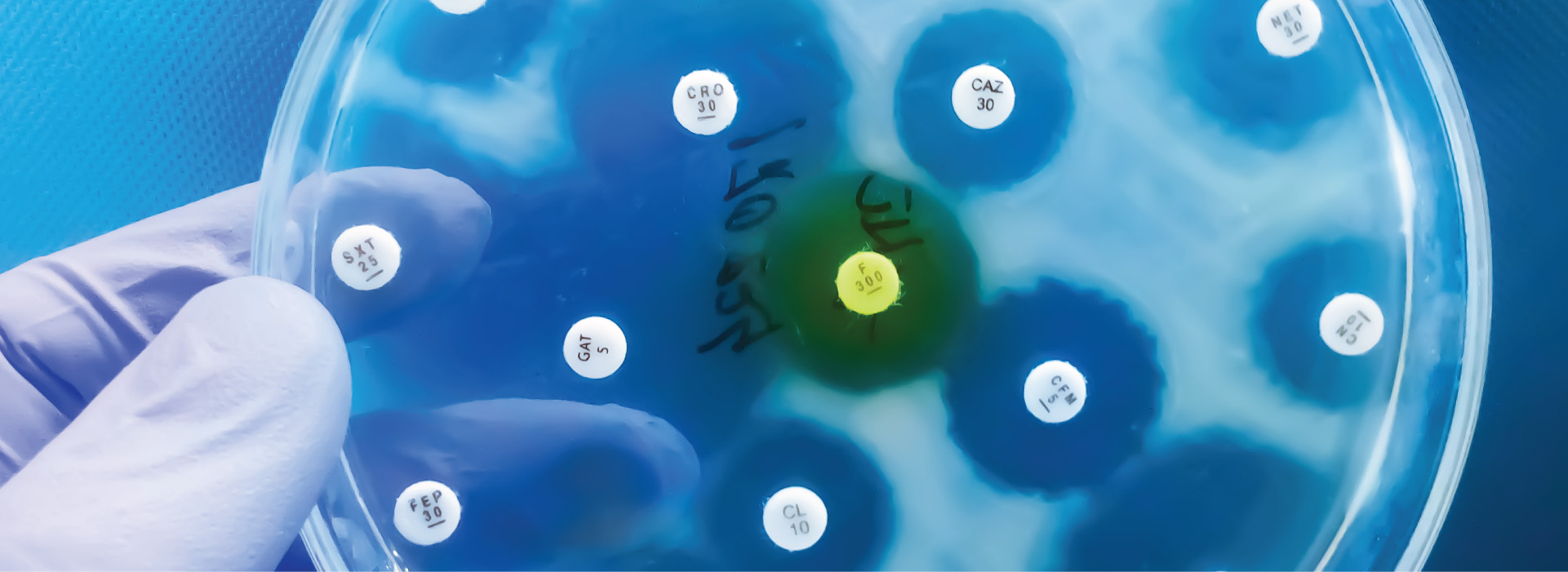On average, only 10% of the human population is left-handed. Interestingly though, 5 out of the last 9 American presidents have been left-handed - Barack Obama, Bill Clinton, George H. W. Bush, Ronald Regan and Gerald Ford (that’s ~ 55%). This macro-scale human motor asymmetry has been of interest for ages. Throughout ancient civilizations, including those of Greece, Rome, China, and Mesopotamia, right-handedness was prevalent, dominant, and revered. It was considered a privilege to sit to the right of someone. In latin, the word for left is sinister, and for right it is dexter. Even back then, these words had double meanings of awkward and skilful, respectively. Today, the meaning of sinister has taken on an even more negative connotation. During the middle ages, it was considered sinful to be left-handed and it was associated with the devil. During The Inquisition, simply being left-handed was enough to condemn a woman as a witch, resulting in the execution of numerous innocent left-handed individuals.1 People have been searching for clues to this asymmetry for ages. Some have even proposed that the greater mortality of left-handers in battles has been a factor driving the higher prevalence of right-handedness today. All myths aside, understanding handedness is also related to understanding brain lateralization, and new research shows that this macro-scale asymmetry can be traced down to the molecular level.
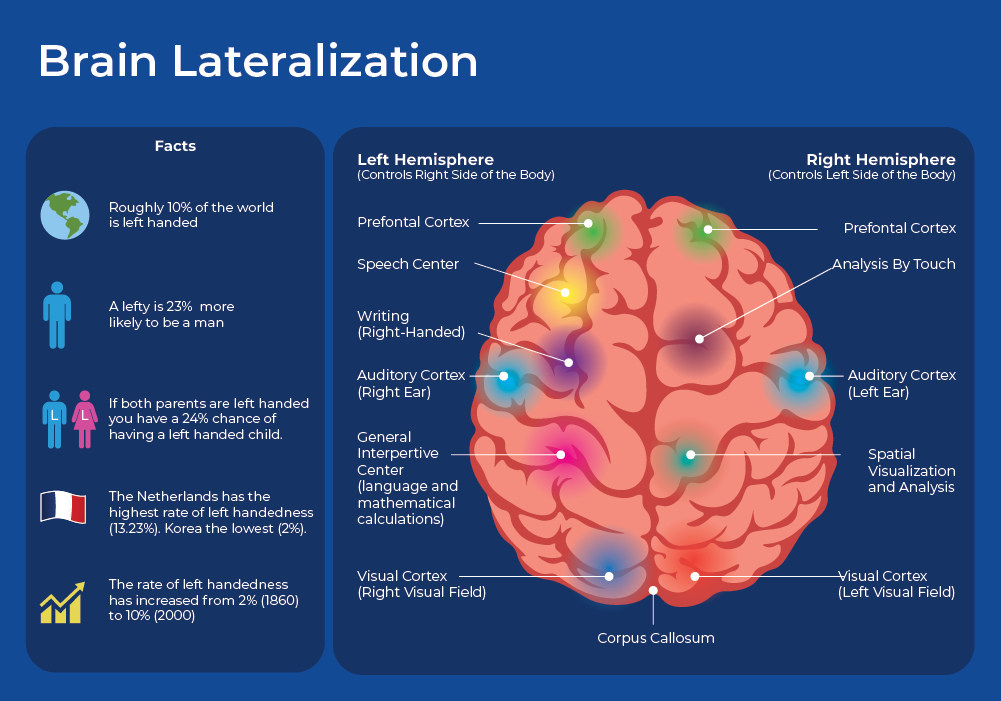
Right Versus Left-Brain
The brain is split into two hemispheres, right and left. Experiments and imaging show that the brain is ‘cross-wired’, with movement of the left-side of the body being mostly controlled by the right hemisphere, and vice versa. In addition, different regions of the brain are responsible for different functions. Research from the 1960s defined the left side of the brain as more logical and mathematical, and the right side of the brain as more creative and emotional. However, more recent research shows that while each side has different specialization, there is extensive communication through the nerve fibers of the Corpus Callosum, and both halves work together. For instance, traditionally, the left hemisphere has been linked with processing mathematical equations. However, research shows that the right hemisphere contributes to spatial awareness during complex calculations, grasping numbers with zeros, and representing numbers in a nonverbal manner. Similarly, language processing has been attributed to the left brain. Nevertheless, the right hemisphere plays a significant role in comprehending context and non-literal language, including metaphors and irony. The importance of the right-hemisphere in the emotional and contextual aspects of language is a possible explanation for lefties as good orators, and a possible explanation for their enrichment in successful politicians. While it is tempting to categorize people as left-brained and right-brained, as people naturally see creativity and logic as opposites, the dichotomy is not nearly so cut and dry. But the reasons for understanding left-handedness are more important than defining personality types, and gross motor lateralization may be part of molecular-based cues in a larger developmental program.
Want to hear more from Norgen?
Join over 10,000 scientists, bioinformaticians, and researchers who receive our exclusive deals, industry updates, and more, directly to their inbox.
For a limited time, subscribe and SAVE 10% on your next purchase!
SIGN UP
Molecular Handedness
As we zoom further inside the body, we see asymmetry at every level. Major organs such as the stomach and liver always reside on the left and right sides of the body, respectively, except in very rare cases. Even within particular organs there is asymmetry, such as the heart with left to right asymmetry. Zooming in even further, most biomolecules are asymmetric, or chiral. What is chirality? Chirality is three-dimensional molecular asymmetry whereby you cannot superimpose a molecule on its mirror image. Chiral molecules can be classified as left-handed or right-handed - a clockwise spiral is considered right handed. Most DNA exists as right-handed double helices. Imagine walking down a DNA staircase, you will be turning to your right. A molecule's handedness plays an important role in its function. For example, nearly all organisms exclusively produce and metabolize left-handed amino acids but utilize right-handed sugars, illustrating the significance of chirality in biological processes. Research is now revealing the mechanistic link between genetics and asymmetry at the level of the cell, organs, and whole organism (left-handed).

What Causes Cell Chirality?
Chirality at the cellular level is defined as a mechanical behavior marked by a preferential orientation or rotation of cells (either clockwise or counterclockwise). It has been suggested that cellular chirality is the foundation of left-right asymmetry at the tissue level. For example, during embryo development, cells actually swirl in a clockwise motion, creating uneven cell distribution. Thus, different types of cells form in certain locations, and ultimately form patterns in many organs.3 In eukaryotic cells, chirality at the cellular level is influenced by the cytoskeleton. The cytoskeleton is composed of three different types of filaments - actin microfilaments, tubulin filaments, and intermediate filaments. The actin filaments provide mechanical support, while the tubulins form microtubules that create a polarized network allowing organelle and protein movement throughout the cell. Microtubules also support the hair-like structure of cilia and contribute to their motility. There is evidence that actin fibers as well as microtubules are both important for determining cell chirality. Furthermore, studies are showing that genetic and epigenetic variation in genes associated with actin and microtubules are implicated in variation at the level of the organ (brain), as well as whole organisms level (left handedness).
Is Being Left Handed Genetic?
Research shows that genetic, epigenetic, environmental and social factors all influence handedness. Interestingly, while the proportion of left-handed twins is in concordance with that of the general population, studies have shown a higher rate of handedness concordance in monozygotic (identical) compared to dizygotic twins, suggesting that genetic factors playing a role for handedness.4 Initial Genome Wide Association Studies (GWAS) struggled to find statistically significant genetic markers of left-handedness. However, the use of biobanks has allowed for studies involving increased population sizes, and subsequent statistically significant findings. Recent GWAS studies have found associations between left-handedness and microtubule-associated genes (eg. TUBB and MAP2 and MAPT). In addition, a GWAS study that collected brain imaging and genome sequencing data from over 32,000 UK Biobank individuals found 27 independent genetic variants that were significantly associated with structural brain asymmetry. Almost half of these loci implicated genes that code for tubulins or microtubule-associated proteins. However, most of those regions were outside of protein coding genes and involved in modulation of gene expression. A recent study published this month utilizing exome data from more than 350,000 individuals in the UK Biobank has identified rare coding variations potentially linked to left-handedness. 5
What is a Biobank?
Biobanks are large collections of biospecimens linked to relevant personal and health information (health records, family history, lifestyle, genetic information) that are held predominantly for use in health and medical research.6 These biospecimens can be blood, plasma/serum, urine, feces, or tissue samples. Alternatively, nucleic acids such as DNA, RNA, cDNA/mRNA, and microRNA can also be stored. Standardized procedures for the collection, preservation, and storage of biospecimens are critical for accurate interpretation of the data. The use of preservation devices can avoid the use of expensive and logistically complex cold storage and shipping.
Norgen Biotek offers a range of sample collection and preservation devices for a variety of biospecimens, including blood, saliva, urine, and feces. As well as a variety of DNA extraction kits.
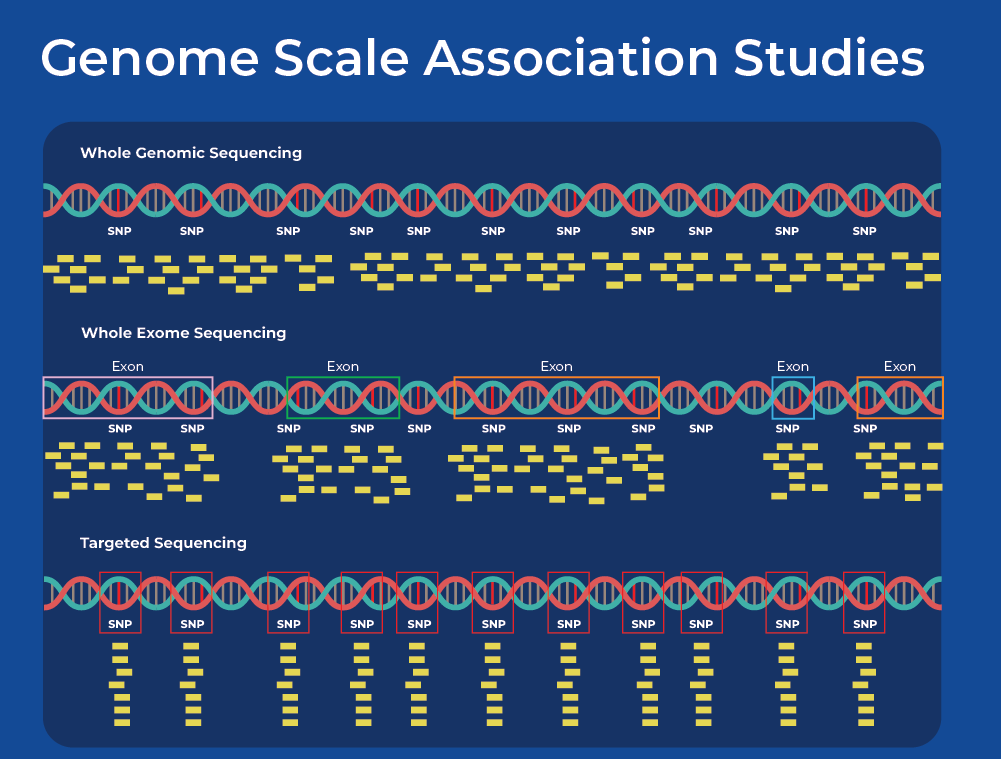
What is the Difference between Exome-Wide and Genome-Wide Association Studies
The main population-wide genomic methods for evaluating genetic variation related to certain diseases or conditions are genome-wide association studies (GWAS), whole-genome sequencing (WGS), and whole-exome sequencing (WES). GWAS studies often involve targeted genotyping of pre-selected variants using microarrays, or selected sequencing. GWAS studies can identify SNPs or structural variations in intronic or exonic regions of the genome. WGS involves sequencing the entire genome of the population, while WES involves only sequencing the exons of the individuals. Although an exome (all exons in a genome are collectively called exome) represents 1-2% of the genome, it is estimated to be responsible for about 85% of mutations identified in Mendelian diseases 7. Exome-wide studies offer the ability to detect rare variants as a greater sequencing depth is achieved for the same cost.
Whole-exome sequencing has traditionally been performed on tissue samples, however, there now seems to be a shift towards plasma and other bodily fluids. The analysis of plasma from a liquid biopsy is much less invasive than a tissue biopsy, and whole-exome sequencing of cf-DNA from liquid biopsies is showing the ability to reveal tumor associated biomarkers and even clues to the tissue of origin.8
Exome-Wide association studies have revealed rare coding genetic variants responsible for a variety of diseases, autism, schizophrenia, Parkinson’s disease, Alzheimer’s disease, and severe COVID19. A recent study used products from Norgen Biotek to investigate Burnside-Butler syndrome. Burnside-Butler syndrome covers a range of developmental and psychiatric symptoms caused by a specific microdeletion on chromosome 15. Researchers performed exome-wide sequencing to determine if genomic variation outside of the 15q11. 2 region influences expression of symptoms in Burnside-Butler syndrome. They collected buccal cells and saliva using Norgen’s Saliva Preservation device (Cat. RU49000), and performed DNA isolation using Norgen’s Saliva DNA Isolation kit (Cat. RU 45400). They identified 453 deleterious genetic variants associated with a variety of symptoms, many of these variants were outside of the four genes in the 15q11. 2 BP1-BP2 microdeletion. Some variants appear to be specific to certain symptoms, such as Autism Spectrum Disorder, while others are not. These results will aid in understanding the genetic factors influencing the diverse neurodevelopmental symptoms in patients with Burnside-Butler syndrome .9
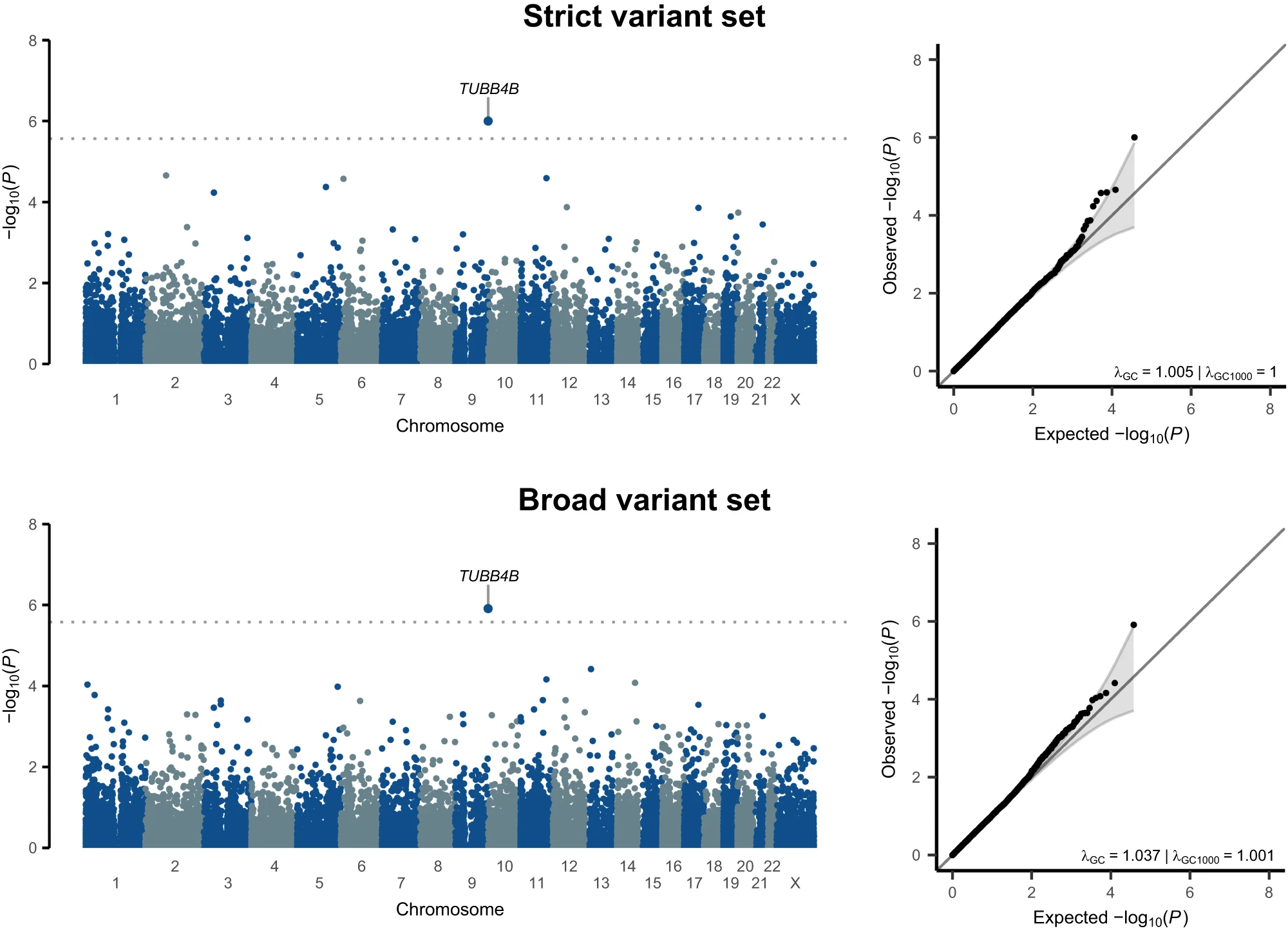
(Schijven et. al., 2024) 5
Whole-Exome Sequencing Reveals a Rare Protein-Coding Variant Associated with Left-Handedness
A new study published this month used the large scale resources at the UK Biobank to analyze exome data from 38,043 left-handed and 313,271 right-handed individuals. Analysis identified rare coding variants in TUBB4B, a tubulin protein, that are substantially increased in left-handers - 2.7 times higher than right-handers. Previous studies have linked TUBB4B variants to sensorineural and ciliopathic disorders. Across the population, most TUBB4B variants are heterozygous missense alterations. However, in this study two frameshift mutations were observed exclusively in left-handed individuals, both of which are predicted to induce degradation of the TUBB4B RNA transcript through nonsense-mediated decay. Thus, both frameshift variants are expected to result in haploinsufficiency. This study also identified variants of two other genes (DSCAM and FOXP1) that were associated with left-handedness, with lower statistical significance. These may be worth further investigation as they are among genes previously implicated in autism or schizophrenia through exome screening.
Although individuals carrying these rare coding variants have a higher likelihood of being left-handed, burden heritability analysis estimated the impact of left-handed heritability due to these variants at only 1 %. Although the exact mechanism behind the impact of microtubules on human handedness is unclear, evidence suggests that the microtubules may contribute to cellular chirality early in brain development, and subsequently to formation of the brain’s left-right axis.
Left Handed Health Problems
Why does all of this matter? Is all this research into left-handedness just for curiosity’s sake? Can left-handedness and brain lateralization affect other areas of health? One study presented evidence that being left-handed may put you at slightly increased risk of accidental injuries and death, probably because most tools, devices, and consumer items are designed for right-handed usage.10 Others have suggested that although left-handed attackers possess an advantage as they can strike opponents from the left side, defending lefties find themselves in a disadvantaged position. Consequently, during confrontational scenarios requiring self-defense, the risk of injury is higher. Although some research has suggested that left-handed individuals have a shorter lifespan, newer research shows that other factors such as changing societal pressures, like the historical forcing of lefties to switch to using their right hand, have confounded this analysis. 11 When modeling takes into account that the proportion of lefties has increased over time, there is no difference in lifespan between lefties and righties. This increase in left-handers over time also presents as a confounding factor when studying the effect of left-handedness on diseases that affect longevity.
However, there does seem to be a significant link between left-handedness and certain psychotic disorders. In a comparison of patients with mental disorders, about 40% of individuals with schizophrenia or schizoaffective disorder are left-handed, which is 4 times higher than the percentage of left-handedness in the general population 2. Transcriptomic and proteomic analysis has shown lower levels of expression of certain tubulin associated genes (TUBA1B) and protein in specific areas of the brain. However, individuals undergoing treatment with antipsychotic drugs did not have lower levels of TUBA1B. These results add to the hypothesis that a breakdown in cytoskeletal homoeostasis may be contributing to the genesis of schizophrenia.12 This is further supported by research into clozapine, one of the only effective drugs targeting schizophrenia. Clozapine directly binds with α and β tubulin heterodimers to inhibit their polymerization during microtubule formation and disturbs the microtubule network. 13
Recent research has also shown that left-handed people are at an increased risk of cardiovascular disease (CVD). Left-handed individuals had lower vascular endothelial function and exhibited an inverse relationship between artery dilation (flow-mediated dilation (FMD)), and mean arterial pressure. FMD is the widening of an artery when blood flow increases. Low FMD is a strong predictor of CVD. For lefties, as the mean arterial pressure increased, the FMD decreased, whereas for right-handers there was no correlation, and FMD stayed constant over a range of arterial pressure. Although there is still some debate as to the overall effect of handedness on life expectancy, some data supports an increased prevalence of some health conditions in left-handed people compared to right. 14






